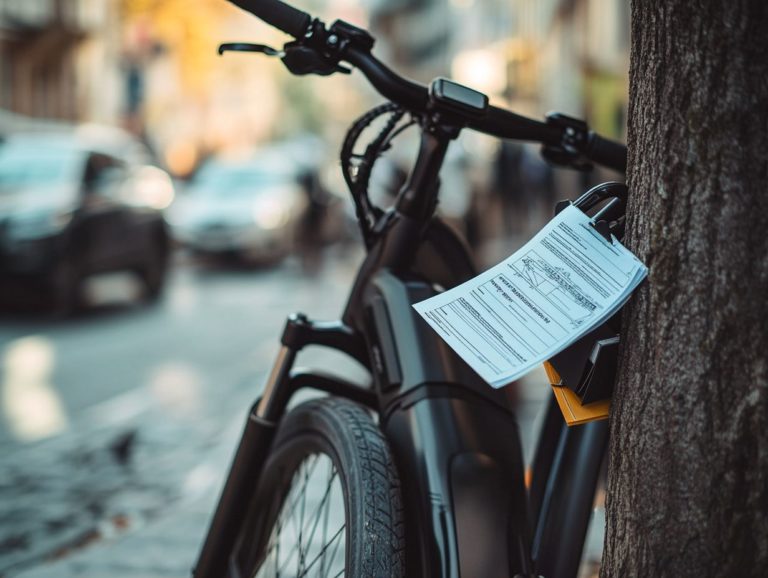Electric Bicycle Lane Laws and Local Ordinances
Electric bicycles, or electric bikes, are swiftly becoming a favored choice for those seeking eco-friendly alternatives to traditional transportation.
However, navigating the complex e-bike laws can feel overwhelming. This article simplifies the classifications of electric bikes, outlines the variations in state and local laws, and examines how local ordinances influence your riding experience.
You ll discover the benefits of these laws for cycling safety and accessibility, all while debunking common misconceptions. Join in as we clarify what you need to know for a seamless riding experience!
Contents
- Key Takeaways:
- Types of Electric Bicycle Lane Laws
- Understanding Local Ordinances
- Benefits of Electric Bicycle Lane Laws
- Common Misconceptions about Electric Bicycle Lane Laws
- Frequently Asked Questions
- What are electric bicycle lane laws and local ordinances?
- Do electric bicycles have to follow the same laws as regular bicycles?
- Are electric bicycles allowed on all bike lanes?
- What is the maximum speed allowed for electric bicycles on bike lanes?
- Can electric bicycles be ridden on sidewalks or pedestrian paths?
- What are the penalties for not following electric bicycle lane laws?
Key Takeaways:
- Understand e-bike classifications to know which laws apply.
- Local laws can greatly affect your e-bike riding experience.
- Electric bicycle lane laws promote safety and accessibility for riders and other road users.
What are Electric Bicycles?
Electric bicycles, or e-bikes, are transforming the way you think about cycling by blending traditional pedaling with cutting-edge electric technology. Their popularity is soaring across the globe, and in places like Florida, you’ll find an array of options from pedal-assist (which means the bike helps you pedal, making it easier to ride) to throttle-assisted models.
E-bikes provide you with an eco-friendly and efficient way to get around, allowing you to cover greater distances with significantly less effort. As e-bike laws continue to evolve, it’s crucial for you to grasp the different classifications like Class 1 e-bikes, Class 2 e-bikes, and Class 3 e-bikes to ensure you ride safely and legally, especially as electric mobility takes center stage in urban transportation discussions.
Each type of e-bike comes equipped with unique components, such as batteries and motors, that enhance their performance. Pedal-assist models require you to pedal to activate the motor, delivering a cycling experience that feels natural. On the other hand, throttle-assisted bikes allow you to command power at will, providing a boost reminiscent of riding a scooter.
Recent studies reveal a remarkable surge in e-bike usage, with sales skyrocketing by 200% in recent years. This explosive growth shows how e-bikes are transforming our daily lives!
The potential to reduce your carbon footprint is significant, as e-bikes can effectively replace those short car trips, promoting not only cycling safety but also fostering a sense of community in urban settings.
Types of Electric Bicycle Lane Laws
Understanding the various electric bicycle lane laws is essential for ensuring your riding experience is both safe and legal, especially in places like Florida.
E-bikes are classified into three categories Class 1, Class 2, and Class 3. This classification significantly influences how they are regulated under local ordinances and e-bike laws.
These regulations determine where you can ride your electric bike, including rules about bike lanes, electric bike registration, and whether certain classes of e-bikes are allowed in public parks and other recreational areas.
Being aware of these laws gives you the power to navigate your community confidently while promoting cycling safety and compliance.
Classifying Electric Bicycles
Electric bicycles fall into three primary classes, each boasting distinct characteristics and regulatory requirements that influence how you can use them and your safety measures on the road.
Class 1 e-bikes are particularly well-suited for recreational cyclists and urban commuters who want to stay active while enjoying some assistance on inclines or during longer rides. If you prefer a more relaxed experience or face mobility challenges, Class 2 e-bikes cater to a broader range of users, making your ride comfortable and enjoyable.
On the other hand, Class 3 e-bikes are crafted for experienced cyclists seeking speed and efficiency, though they often come with specific limitations on where you can ride them. By understanding these categories, you ensure compliance with local laws while prioritizing your safety on the road.
Explore your local e-bike laws today and enjoy your ride!
Differences in State and Local Laws
Electric bicycle laws can be confusing, as regulations vary widely from state to state and even among local jurisdictions. In Florida, for instance, you ll find specific regulations that intertwine local ordinances with state laws, impacting where you can legally ride your electric bike.
Safety requirements might differ depending on your location. This includes aspects like helmet mandates, speed limits, and even insurance requirements for e-bike usage. Knowing these differences keeps you safe while riding!
In California, e-bikes belong to three classes, each with unique rules. This allows cities like San Francisco to set stricter regulations.
On the other hand, New York has opted for a more streamlined classification system with statewide regulations. However, New York City has its own rules that can differ significantly, including specific safety requirements for e-bike usage.
These inconsistencies highlight the necessity for you to familiarize yourself with local laws. Don t risk fines learn the rules now!
Understanding Local Ordinances
Understanding local ordinances is essential for electric bike riders who want to be aware of the rules governing where and how they can operate. Local laws can outline specific rules about using bike lanes, access for electric bikes in public parks, and safety mandates like helmet use.
As cities prioritize electric mobility in their transportation strategies, being aware of these ordinances allows riders to enjoy electric bike usage without running into legal issues.
Municipalities often change their laws to foster community integration and promote sustainable transportation options.
How Local Laws Affect Electric Bicycle Use
Local laws significantly shape your experience with electric bicycles, dictating where you can ride and under what conditions. These regulations often determine your access to bike lanes designed for e-bikes and outline safety requirements for equipment like lights and helmets.
When an area has well-defined bike lanes, it creates a safer environment for electric bike usage, encouraging more residents to consider e-mobility as a practical transportation option.
Cities that proactively adapt their policies to include electric bikes often witness a significant increase in their utilization. Take Portland, Oregon, for example. Local authorities have invested in new bike lanes tailored specifically for e-bikes, ensuring safe passage through busy corridors.
In Amsterdam, involving community members in discussions about bike safety has led to initiatives designed to reduce accidents and bolster rider confidence.
By fostering collaboration among city planners, law enforcement, and local riders, municipalities can cultivate an environment where electric bikes thrive. This enhances public health and community welfare, promoting a healthier lifestyle for residents.
Benefits of Electric Bicycle Lane Laws
Electric bicycle lane laws present a wealth of advantages, significantly elevating cycling safety, championing electric mobility, and nurturing community integration.
By implementing clear regulations, these laws empower electric bike riders to traverse roadways with confidence, minimizing accident risks and inspiring more people to embrace cycling as a viable transportation option.
The establishment of designated bike lanes and electric bike-friendly zones fosters public health by promoting physical activity and alleviates congestion, thereby enriching the overall quality of life in urban environments.
Get informed and ride safely check your local laws today!
Promoting Safety and Accessibility
Promoting safety and accessibility through electric bike lane laws is vital for building a strong biking community. These laws clearly define helmet requirements and other safety measures, creating safer environments for all cyclists, including electric bike riders. They ensure bike lanes are well-defined and accessible, especially in public parks and recreational areas.
When cycling safety measures, such as clear signage and designated paths, are integrated, more individuals are encouraged to embrace electric biking. Act now to boost community spirit and embrace a healthier lifestyle!
Research has shown that communities with dedicated bike lanes see a significant reduction in accidents, making streets safer for everyone. For instance, a study from Portland revealed that implementing bike lane regulations resulted in a 20% decrease in cycling injuries over three years.
These regulations not only protect cyclists but also invite a diverse array of individuals, including those facing mobility challenges, to join the biking fun! By improving access to essential public spaces, the positive impact on community health can be substantial. Increased biking promotes physical fitness and reduces reliance on cars, which helps lower pollution levels.
The long-term benefits foster healthier lifestyles, creating a vibrant community where residents actively engage with one another and their environment.
Common Misconceptions about Electric Bicycle Lane Laws
Common misconceptions surrounding electric bicycle lane laws can create confusion for riders, particularly regarding safety requirements and legal usage.
Many people mistakenly assume all e-bikes are governed by the same regulations, overlooking the important distinctions between pedal-assist bikes and throttle-assisted bikes those that can be powered without pedaling especially in states like Florida.
Misunderstandings about helmet requirements and the legal riding areas for electric bikes can discourage potential users, ultimately hindering the growth of electric mobility in communities.
Debunking Myths and Clarifying Facts
Debunking myths and clarifying facts about electric bike laws is essential for promoting your safe and responsible use of e-bikes. One prevalent myth you might encounter is the belief that all e-bikes require registration. This actually varies by jurisdiction and often hinges on how the bike is classified under local e-bike laws.
You may also think that wearing a helmet is a universal requirement, but that can differ significantly from one region to another, even within Florida. By addressing these misconceptions, you can help cultivate a more informed community that fully embraces the advantages of electric mobility.
Understanding the specifics of local regulations is crucial for you as an e-bike user to navigate your rights and responsibilities safely. For example, some areas allow you to ride e-bikes on bike paths without needing a driver’s license, while others impose strict age requirements. To ensure compliance, consider navigating electric bicycle licensing requirements in your region.
Another common misunderstanding is that electric bicycles are treated the same as motor vehicles, which isn’t always the case. Many localities have dedicated lanes and specific rules tailored for e-bikes. Clarifying these nuances, such as understanding electric bicycle laws in California, not only helps you avoid legal pitfalls but also encourages more individuals to discover the perks of electric biking for both commuting and leisure.
Frequently Asked Questions
What are electric bicycle lane laws and local ordinances?
Electric bicycle lane laws and local ordinances are laws and regulations that specifically apply to the use of electric bicycles on designated bike lanes and on local roads. These laws aim to ensure the safe and proper use of electric bicycles, as well as to address any potential conflicts with other road users.
Do electric bicycles have to follow the same laws as regular bicycles?
Yes, in most cases, electric bicycles have to follow the same laws as regular bicycles. However, there may be specific laws and ordinances that apply only to electric bicycles, such as speed limits or restrictions on where they can be ridden.
Are electric bicycles allowed on all bike lanes?
It depends on the specific laws and ordinances in your area. In general, electric bicycles are allowed on bike lanes that are designated for use by bicycles. However, some bike lanes may have restrictions on motorized vehicles, including electric bicycles. Check your local laws to ensure compliance.
What is the maximum speed allowed for electric bicycles on bike lanes?
The maximum speed for electric bicycles depends on local laws. Some areas set the same speed limit as regular bicycles, while others allow higher speeds.
Can electric bicycles be ridden on sidewalks or pedestrian paths?
Generally, electric bicycles are not allowed on sidewalks or pedestrian paths. These spaces are typically for pedestrians only and can be dangerous for them.
What are the penalties for not following electric bicycle lane laws?
Penalties vary based on the violation and local laws. Fines or tickets may be issued, and in serious cases, you could lose your ability to ride an electric bicycle.




